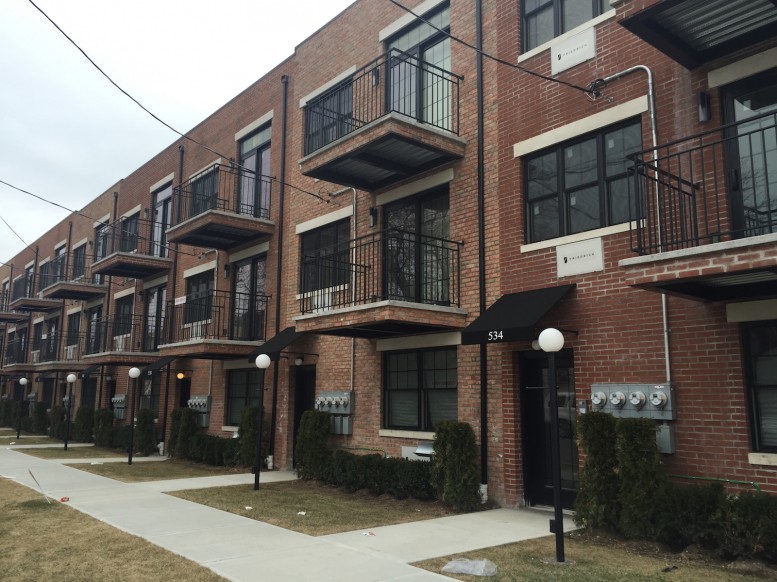Mayor de Blasio unveiled his grand plan to fix 421-a this week, and his proposal requires any developer who wants to take advantage of the property tax exemption to set aside 25 to 30 percent of their units as affordable housing.
Currently, owners of new condo or rental buildings in much of the outer boroughs get to dodge property taxes for up to 25 years. In Manhattan below 110th Street and gentrified parts of Brooklyn and Queens, developers have to include 20% below market housing in order to qualify for the exemption.
However, the mayor’s new proposal extends the tax abatement from 25 to 35 years, in an attempt to make the measure more palatable to developers.
Also, condos would no longer be able to qualify for 421-a, making it more expensive to build projects in the city’s most affordable neighborhoods, like Canarsie, Midwood, or the outer edges of the Bronx and Queens.
“We’ve had a lot of teachers, nurses. You get a lot of people this is the first property they are purchasing,” developer Moishe Loketch told the Awl about his Canarsie condo project, which was built with the standard 15-year 421-a abatement. Prices at the 27-unit complex range from $379,000 for a 1,000-square-foot two-bedroom, two-bath to $429,000 for a 1,350-square-foot three-bedroom, 2.5-bath unit.
Those prices are about on-point for new construction condos in the neighborhood (the few that exist) and much lower than condos in gentrifying areas, like Crown Heights and Bed Stuy.
It seems attractive to kill the measure that gave $35 million in tax abatements to luxury condo tower One57, but we don’t see why builders throughout the five boroughs should suffer—particularly if they can offer reasonably priced opportunities to own a home or condo.
However, the bigger question is whether the proposed 421-a rules will encourage rental development. In expensive parts of Manhattan and Brooklyn, developers building high-rises will see some benefits, since they’ll still get a floor area bonus (extra square footage) for including affordable housing.
And those “affordable” units would be close to market-rate in certain neighborhoods. The highest rents would clock in at $2,800 a month for a two-bedroom, which the city considers affordable for households making up to 130 percent of the city’s Area Median Income, or roughly $112,000 a year for a family of four.
These high-density neighborhoods will also benefit from zoning changes, which will allow market-rate developers to build 5’ to 10’ feet higher, and offer builders who include below-market units up to 50’ in additional height.
Still, requiring additional affordable housing in order to qualify for the tax abatement will likely hurt smaller developers in outlying neighborhoods, like East New York, Jamaica, and much of the Bronx. 421-a made it easier to build in areas with lower rents, where development wouldn’t pencil out at all without the abatement.
Even though the administration plans to upzone East New York and Jerome Avenue in the Bronx, added density in those hoods may not be enough to guarantee that developers can afford to finance taller buildings. And the city’s plan to impose mandatory inclusionary zoning in these areas will hurt developers’ bottom lines even more. (Under mandatory inclusionary zoning, anyone building new construction has to set aside some of their apartments as affordable housing.)
As the Furman Center noted in a report earlier this year: “In neighborhoods with market rents in this [low] range, developers may now seek to build fully market-rate developments, but they may opt not to build if they are required to include a significant component of affordable housing at, say, 60 percent of AMI.”
Here are the thresholds they’re talking about, in a helpful chart:
Finally, shouldn’t the city be trying to incentivize development in housing-starved, low-income neighborhoods? Jackson Heights, Elmurst/Corona, and Mott Haven/Melrose in the South Bronx have the more people crammed into each apartment than nearly anywhere else in the city. Those areas, along with middle-income Borough Park and Sunset Park, are the only places that averaged more than three people living in a single apartment in 2010, according to the Furman Center’s State of the City report.
Ultimately, developers are less likely to bring affordable market-rate housing to these neighborhoods if they have to include apartments priced below already low rents.
Legislators in Albany now get to decide whether to extend 421-a as is or renew it with de Blasio’s reforms. Their decisions are influenced not only by the real estate lobby, which supports the mayor’s plan, but also by recent corruption charges against Republican State Senate leader Dean Skelos, whose criminal case involves a few top developers.
Subscribe to YIMBY’s daily e-mail
Follow YIMBYgram for real-time photo updates
Like YIMBY on Facebook
Follow YIMBY’s Twitter for the latest in YIMBYnews




You should clarify that developers don’t get to “dodge” paying taxes…post construction they still pay the same taxes that existed pre-development and are only exempt from the increase due to the new project…
421a was amended a few years ago to only be a partial abatement up to $65,000 of the tax assessed value, anything higher than that is fully taxable for the last few years.
I think cutting 421-a for condos is right. Condos already receive massive property tax breaks thanks to the city’s bizarre valuation methods, so piling 421-a on top of that doesn’t seem right. Wish they’d bring back 421-b to get more single-family places turned into townhouses, duplexes, etc., though.
No analysis of 421-A is complete, or even meaningful, without an estimate of what it costs the City in forgone taxes.
MR Diblasio should make an appointment for a phsychiatric evaluation and recieve the appropriate mental help